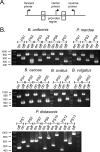Niche-specific features of the intestinal bacteroidales
- PMID: 17993536
- PMCID: PMC2223690
- DOI: 10.1128/JB.01559-07
Niche-specific features of the intestinal bacteroidales
Abstract
By analyzing the genomic sequences of 12 Bacteroidales species, we found that all intestinal species have numerous polysaccharide biosynthesis loci, many with promoters that we demonstrate undergo DNA inversion. This feature is not conserved in the Bacteroidales order as a whole, as oral species do not share these genetic features.
Figures


Similar articles
-
Evidence of extensive DNA transfer between bacteroidales species within the human gut.mBio. 2014 Jun 17;5(3):e01305-14. doi: 10.1128/mBio.01305-14. mBio. 2014. PMID: 24939888 Free PMC article.
-
Trans locus inhibitors limit concomitant polysaccharide synthesis in the human gut symbiont Bacteroides fragilis.Proc Natl Acad Sci U S A. 2010 Jun 29;107(26):11976-80. doi: 10.1073/pnas.1005039107. Epub 2010 Jun 14. Proc Natl Acad Sci U S A. 2010. PMID: 20547868 Free PMC article.
-
Characterization of adherent bacteroidales from intestinal biopsies of children and young adults with inflammatory bowel disease.PLoS One. 2013 Jun 11;8(6):e63686. doi: 10.1371/journal.pone.0063686. Print 2013. PLoS One. 2013. PMID: 23776434 Free PMC article.
-
Bacteroidetes bacteria in the soil: Glycan acquisition, enzyme secretion, and gliding motility.Adv Appl Microbiol. 2020;110:63-98. doi: 10.1016/bs.aambs.2019.11.001. Epub 2019 Dec 5. Adv Appl Microbiol. 2020. PMID: 32386606 Review.
-
Interbacterial warfare in the human gut: insights from Bacteroidales' perspective.Gut Microbes. 2025 Dec;17(1):2473522. doi: 10.1080/19490976.2025.2473522. Epub 2025 Mar 4. Gut Microbes. 2025. PMID: 40038576 Free PMC article. Review.
Cited by
-
Chemoenzymatic synthesis of an isoprenoid phosphate tool for the analysis of complex bacterial oligosaccharide biosynthesis.Carbohydr Res. 2012 Oct 1;359:44-53. doi: 10.1016/j.carres.2012.06.014. Epub 2012 Jul 1. Carbohydr Res. 2012. PMID: 22925763 Free PMC article.
-
Longitudinal analysis of the prevalence, maintenance, and IgA response to species of the order Bacteroidales in the human gut.Infect Immun. 2011 May;79(5):2012-20. doi: 10.1128/IAI.01348-10. Epub 2011 Mar 14. Infect Immun. 2011. PMID: 21402766 Free PMC article.
-
Orientations of the Bacteroides fragilis capsular polysaccharide biosynthesis locus promoters during symbiosis and infection.J Bacteriol. 2010 Nov;192(21):5832-6. doi: 10.1128/JB.00555-10. Epub 2010 Aug 20. J Bacteriol. 2010. PMID: 20729352 Free PMC article.
-
Carbohydrate Deacetylase Unique to Gut Microbe Bacteroides Reveals Atypical Structure.Biochemistry. 2025 Jan 7;64(1):180-191. doi: 10.1021/acs.biochem.4c00519. Epub 2024 Dec 11. Biochemistry. 2025. PMID: 39663570 Free PMC article.
-
Antioxidant Vitamins and Prebiotic FOS and XOS Differentially Shift Microbiota Composition and Function and Improve Intestinal Epithelial Barrier In Vitro.Nutrients. 2021 Mar 29;13(4):1125. doi: 10.3390/nu13041125. Nutrients. 2021. PMID: 33805552 Free PMC article. Clinical Trial.
References
-
- Aduse-Opoku, J., J. M. Slaney, A. Hashim, A. Gallagher, R. P. Gallagher, M. Rangarajan, K. Boutaga, M. L. Laine, A. J. Van Winkelhoff, and M. A. Curtis. 2006. Identification and characterization of the capsuylar polysaccharide (K-antigen) locus of Porphyromonas gingivalis. Infect. Immun. 74449-460. - PMC - PubMed
-
- Bailey, T. L., and C. Elkan. 1994. Fitting a mixture model by expectation maximization to discover motifs in biopolymers, p. 28-36. In R. Altman, D. Brutlag, P. Karp, R. Lathrop, and D. Searls (ed.), Proceedings of the Second International Conference on Intelligent Systems for Molecular Biology. AAAI Press, Menlo Park, CA. - PubMed
-
- Bayley, D. P., E. R. Rocha, and C. J. Smith. 2000. Analysis of cepA and other Bacteroides fragilis genes reveals a unique promoter structure. FEMS Microbiol. Lett. 193149-154. - PubMed
-
- Cerdeno-Tarraga, A., S. Patrick, L. Crossman, G. Blakely, V. Abratt, N. Lennard, I. Poxton, B. Duerden, B. Harris, M. Quail, A. Barron, L. Clark, C. Corton, J. Doggett, M. Holden, N. Larke, A. Line, A. Lord, H. Norbertczak, D. Ormond, C. Price, E. Rabbinowitsch, J. Woodward, B. Barrell, and J. Parkhill. 2005. Extensive DNA inversions in the B. fragilis genome control variable gene expression. Science 3071463-1465. - PubMed
Publication types
MeSH terms
Substances
Grants and funding
LinkOut - more resources
Full Text Sources
Other Literature Sources

